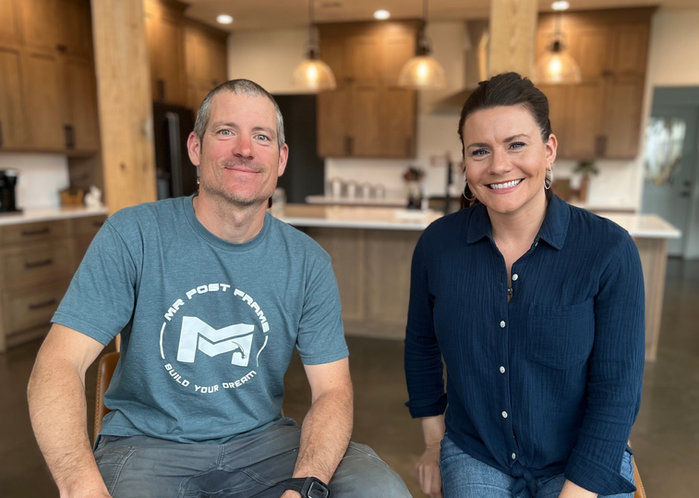Metal Roof + Trim | Post Frame Home | Part 2
- MR Post Frame
- Dec 21, 2023
- 3 min read
Welcome back to the MAD County Build Series. I'm back with another update on my roofing project. Yesterday was quite a productive day. I managed to install the east side of the roof, and it went surprisingly well. So, today, I'm diving into the soffit work on the end wall. As you can see, I've already got one side nearly done.

Now, let's walk through the process I follow. First things first, I'm working on the fascia board, which is a 2x6, measuring about five and a half inches in width. To get started, I come to the top of the purlins because that's level with the top of my fascia board.
From there, I mark five and a half inches down and then snap a chalk line. This chalk line serves as the guide for fastening the top edge of my F channel. The F channel is what the soffit slides into, making it all neat and secure.
I'd also like to introduce you to this trusty Dewalt narrow crown stapler I use. It's versatile because you can adjust the depth of the staple, ensuring that you don't over-penetrate the aluminum and risk tearing it. This thing speeds up the process significantly.

Now, when it comes to the soffit, I have a nifty little trick to share. On the sidewall, the soffit fits in a specific way, and I take a 2x4, rip it to two inches, and place it in there. This brings the bottom of the soffit flush with the fascia board. Then, I notch the end of the 2x4 to ensure a snug fit. It's all about getting that seamless, clean look.
Now, on to the bottom of the overhang – this is where it gets interesting. I have to ensure birds and critters can't sneak in there. To achieve that, I take a piece of flat aluminum and slide it in there, securing it with a few screws. This piece acts as an extra layer of protection, sealing off any potential entry points.
As you may have noticed, I like to keep the number of screws to a minimum. I usually put three screws on a 12-foot piece of fascia, one at each end and one in the middle. The fewer screws, the better. You don't want to risk warping the fascia board due to too many fasteners.
Now, it's time for a bit of overlapping. Overlapping is key, especially on the side where everyone enters from the driveway. I make sure to overlap the seams about two inches, which conceals them when viewed from the main entrance or where most people will be. I use a simple technique involving a tab and some precise cutting to ensure a seamless overlap that looks neat and tidy.

One more essential detail is the ridge cap. It's the finishing touch that goes on top of the roof to seal it up. It has weather strips to keep out wind-driven rain while allowing the building to breathe.
And there you have it! All the soffit, fascia, and trim are in place, and the ridge cap is on top of the roof. It's been quite a journey with a lot of work, but the results are worth it. Stay tuned for more updates, and here's hoping the weather holds up for the next phase of this project!
If you have any questions or need further clarification, don't hesitate to comment. I'm here to assist, and if there are recurring questions, I'll consider creating more in-depth posts.

Thank you for joining me on this adventure, and stay tuned for more insights in the MAD County Build Series!
Sincerely,
Mr Post Frame

Patreon Group
Interested in tackling your build on your own? If you want to explore the possibility of being your GC or self-building, our Patreon membership is for you! It's a community of like-minded people offering support, discounts, Q/A, and more.